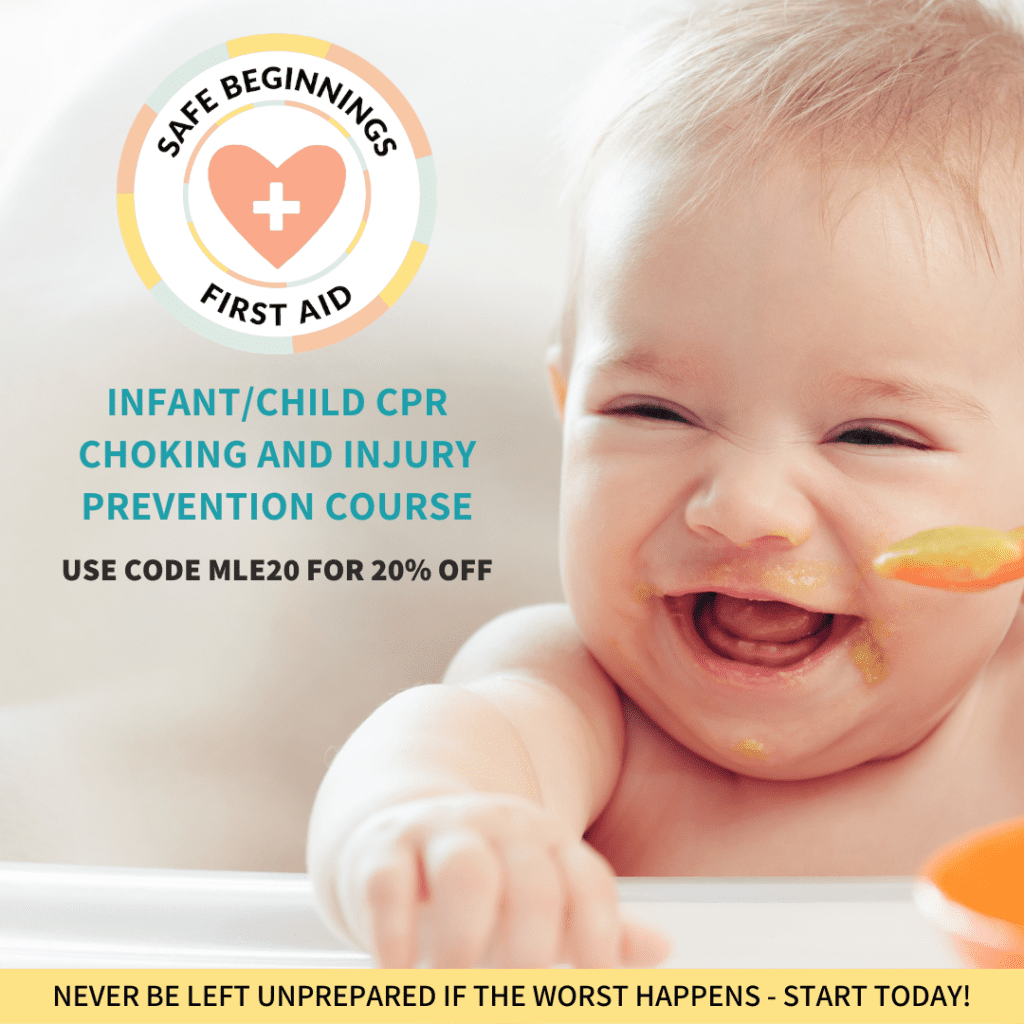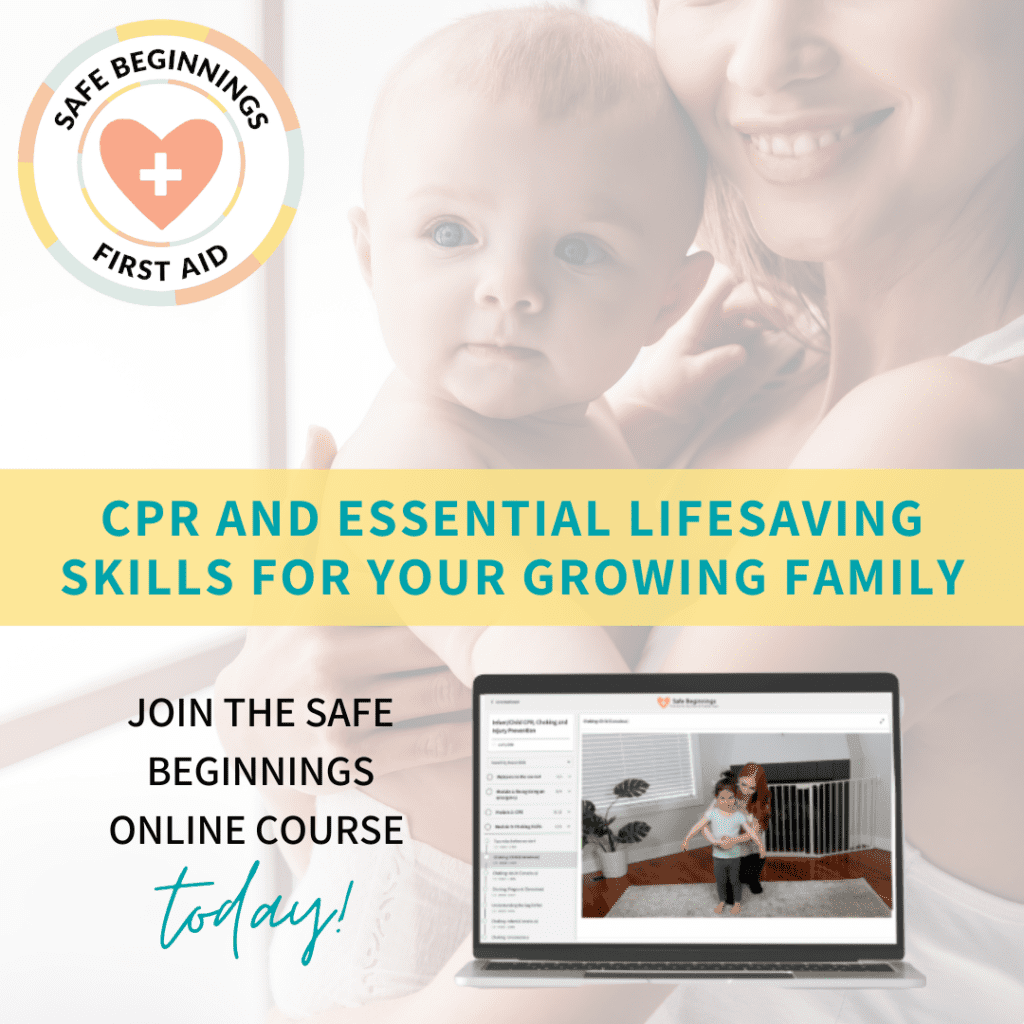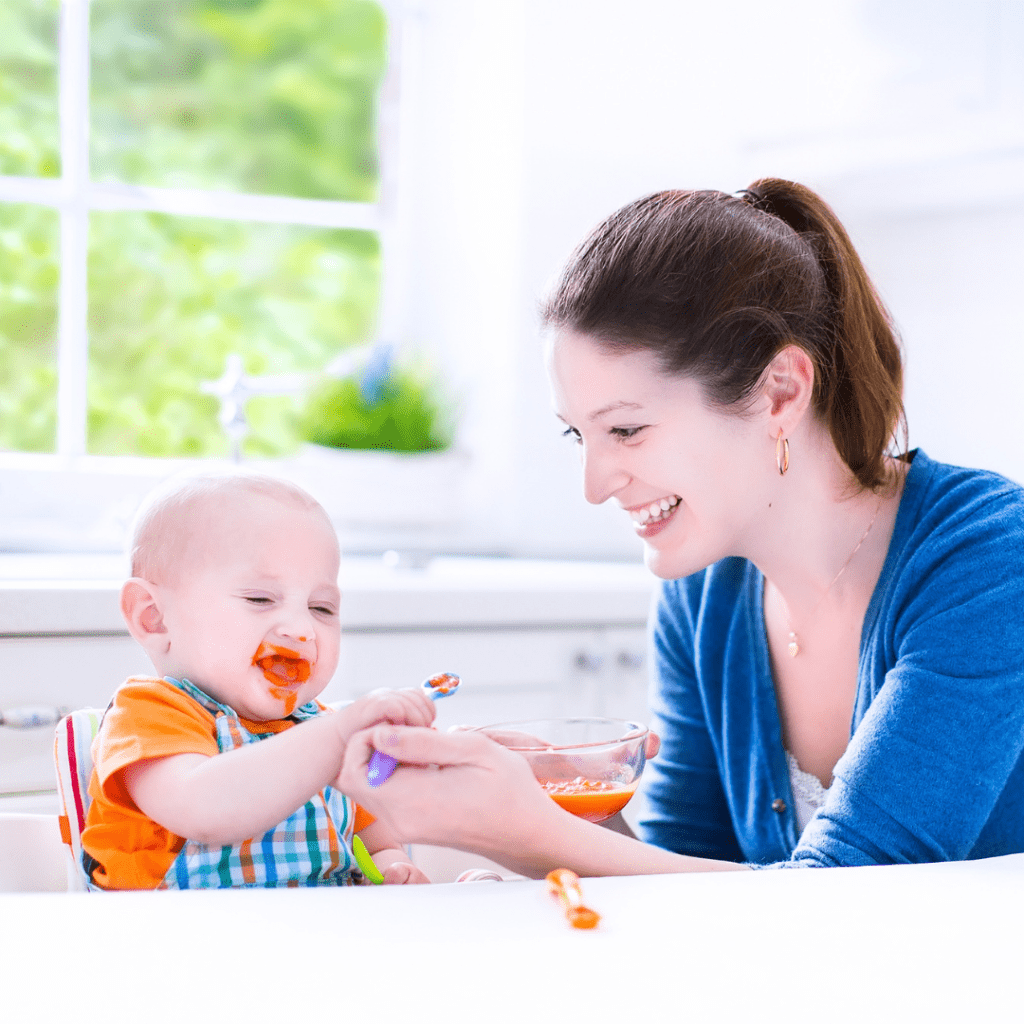This post may contain affiliate links, please view our disclosure policy for more details.
When googling “What do you need to start solids with baby”, you’ll inevitably find lots of information on the best highchairs, cups, plates, bibs, spoons, and even foods to introduce.
But the one thing that always seems to be left off the list that is an absolute must in the eyes of this pediatric dietitian and feeding expert, is the importance of taking an infant CPR course – ideally before starting solids!!
You see, gagging and choking on food is the #1 concern most parents and professionals have when it comes to feeding babies, and while having a good suction plate or the latest highchair is helpful, nothing is as helpful as child safety knowledge and knowing how to respond if the very real risk of choking should come up.
After reviewing a couple of different infant and child CPR courses (one in-person course in the Halifax area, and two online courses), I can very confidently say that the Safe Beginnings Infant/Child CPR course is the very best one out there.
This course is the only one that describes all information thoroughly, with video, going through every frequently asked question, and allows you to watch it over and over again with lifetime access so you never have to worry about forgetting the information. I couldn’t rave more about this course as a must-have on anyone’s baby registry, to ensure your baby is as safe as possible throughout their journey with solid foods.
You can get 20% off the course using code MLE20 by clicking this link here.
Let’s get into the details of what an infant/child CPR course can do for you, why you need to take it before starting solids, and more on the benefits of the Safe Beginnings course specifically.
Table of Contents
Why you need to take an infant CPR class before starting solid foods
Reason #1: Babies can choke even when doing things perfectly
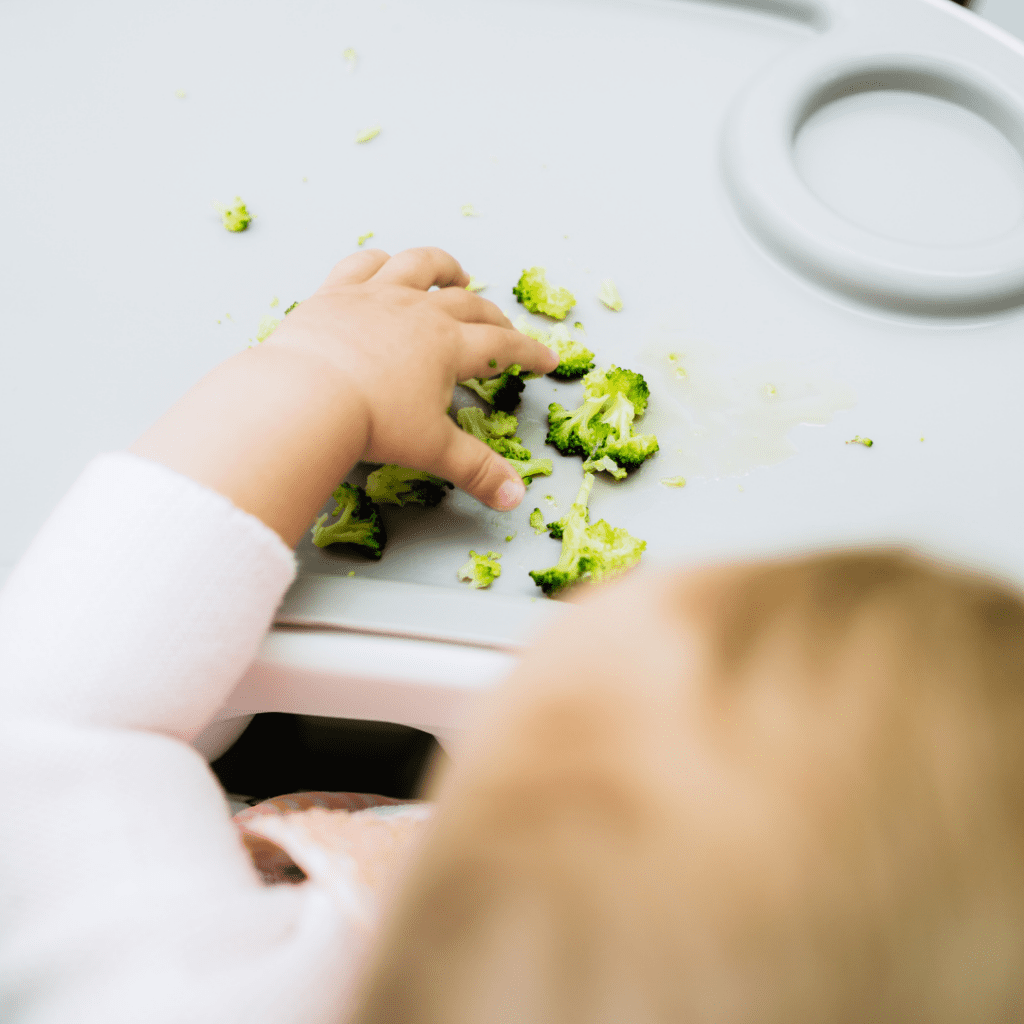
You can be starting with purees and still babies can choke. You can study how to serve every single food, and still, babies can choke. No matter how safe foods are or whether they’re served in the best way for your child’s developmental abilities, any child can choke, at any age, on any type of food.
I do want to be clear that the risk of choking on finger foods is no different than the risk of choking on purées when the parents are properly educated on how to serve finger foods safely (1). Researchers came to this conclusion after studying the effects of a baby-led introduction to solids, in a popular research study known as “BLISS” (baby-led introduction to solids). But, this is only true when parents and caregivers are educated about reducing choking risk.
Choking and suffocation are responsible for almost 40% of unintentional injuries in infants under the age of one in Canada (2). Just think about how much lower that statistic would be if every parent out there was educated on how to prevent choking, and had the confidence to intervene with infant and child CPR. Choking happens, so it’s better to be educated and prepared. It could save your child’s life!
My son’s scary encounter with choking
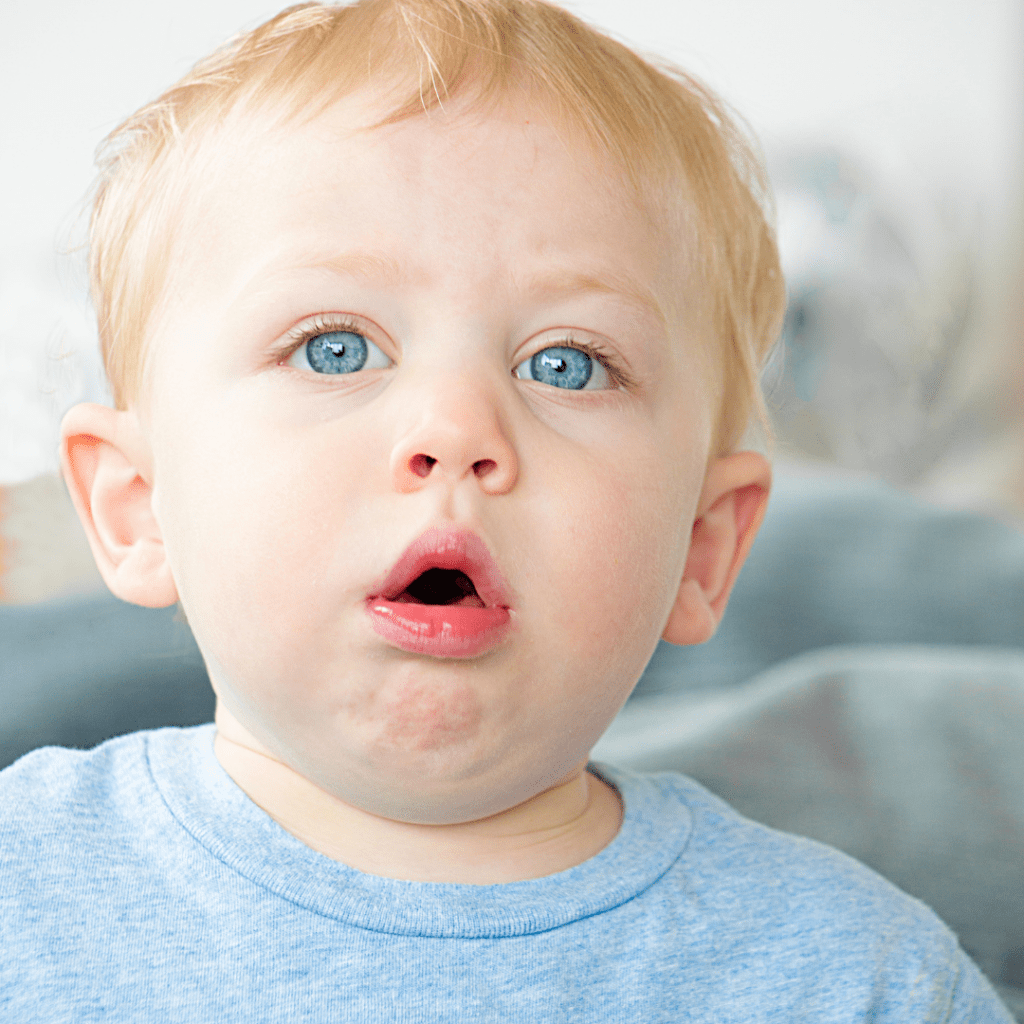
Telling the story of when my youngest son choked at 5 years old is really difficult for me, as it was, quite frankly, traumatizing. It was the scariest moment of my life – and to admit that I had NO IDEA what to do brings back all those feelings of helplessness that I felt then.
We were at a family cottage, and all the kids and adults were sitting together around the table, eating barbequed hotdogs and burgers. It was fun, it was relaxed…until it wasn’t.
All of a sudden, my son stood up and started grabbing his throat, mouth wide open and tongue forward, with a look of panic in his eyes.
I had no idea what to do.
My heart felt like it was jumping out of my chest. I wasn’t trained in CPR for older kids/adults and I felt completely helpless. What I did know about CPR for infants was long forgotten now that he was 5.
Thankfully, my sister-in-law was there and knew exactly what to do.
She immediately jumped up and acted so quickly and confidently! She swiftly grabbed him from behind and started to perform the Heimlich maneuver on him. Within a few seconds, the piece of hotdog flew out of his mouth.
But when it was all over, and the panic subsided, I thought to myself…aren’t hotdogs only a hazard up until age 4?! At the same time, there are other foods that I (and many other parents) gave kids before the age of 4 (like chips, carrots, etc.) without a second thought, and nothing ever happened to them. So what gives?
Well…these guidelines are just that…guidelines…and they act as sort of a blanket statement. There’s nothing magical about the day your child turns 4. It’s more like the assumption is made that by that time they can chew very well, and maturely, and therefore don’t have as high of a risk to choke on food. It doesn’t mean that they’ll for sure choke on it under age 4, or that your toddler isn’t able to handle it…and it doesn’t mean that the risk has completely dwindled down to 0% the day they turn 4. Choking on foods can happen at any age, even as adults.
But I don’t want you to freak out!! That doesn’t mean we don’t eat all of these foods, and that doesn’t mean your child can’t either!
Instead, just educate yourself on the best ways to serve these foods, based on your judgment, combined with official recommendations, and know that having the confidence to intervene with infant and child CPR – again – is a must!!!
That’s why we’ve joined up with Safe Beginnings to offer you a Baby Beginnings Bundle. Our Baby Led Feeding course so you can learn how to serve food in the safest way for your baby and their Infant CPR class so you’re prepared just in case. Plus, we even gave you a discount for buying them together!
Reason #2: Learning how to do infant CPR takes time

Learning how to perform infant CPR accurately takes time. Reviewing a pamphlet or quickly scrolling through a website won’t do. You’ll need to pay close attention and have an understanding of how to physically perform CPR without causing harm.
If you attend a CPR class, you’re typically there all day and complete about 6-7 hours of learning. It’s absolutely amazing that you can get hands-on with a doll and demo it in front of an instructor, and this is the best and only way to get certified in CPR (which may or may not be important to you) – however – there is no way of revisiting the information besides whatever notes you take. You won’t have a way of watching videos/demos and you (like me and my story above) may end up forgetting how to do things after a few months or years.
An online course like Safe Beginnings Infant/Child CPR, Choking & Injury Prevention Course doesn’t take nearly as long to complete – it’s about 2 hours and 15 minutes – but it is going to provide you with all of the detailed information you need. Plus, you can start and stop it whenever you want and complete it at your own pace. If you need more practice or further understanding of certain topics, you can go back and rewatch them, and the course provides lots of handouts for easy reference too.
Reason #3: When you know infant CPR, it's VERY effective

One thing that I learned from Holly Choi (the course instructor) that really stuck out to me was that when you know how to perform CPR correctly, it’s very effective on small children.
Case in point is my personal experience with my son – while not an infant, I think the same logic applies. Once my sister-in-law intervened, the hot dog was dislodged in seconds. Not minutes…seconds.
The same goes for infant CPR. If you’ve ever had to administer CPR, you know what I’m talking about. It feels like an eternity, but in reality, it works very quickly.
However, infant CPR is ONLY this effective when you know how to do it correctly. You need to be confident, you need to react quickly and act fast, and you need to perform the procedure properly.
You have about 30-60 seconds to dislodge the food before unconsciousness happens. Again, I’m not trying to scare you because when you know how to do this it can be done in about 5 seconds – often it’s a matter of only 2 back blows before the food is dislodged. Even if you’re absolutely terrified, shaking, and it takes you 15 seconds to get them out of their chair, for example, you will still be well under that window of 30-60 seconds.
You have the time when you have the knowledge.
What you don’t want to happen is you freeze because you have no idea what to do. If you have to look up the emergency procedure in the moment or call 911 to get advice, who knows how long that will take? Please don’t risk getting stuck in this scenario.
Listen to Holly talk about all of her best tips, including the details I shared above, in the podcast episode below.
Reason #4: Knowing infant CPR reduces anxiety and makes mealtimes more pleasant
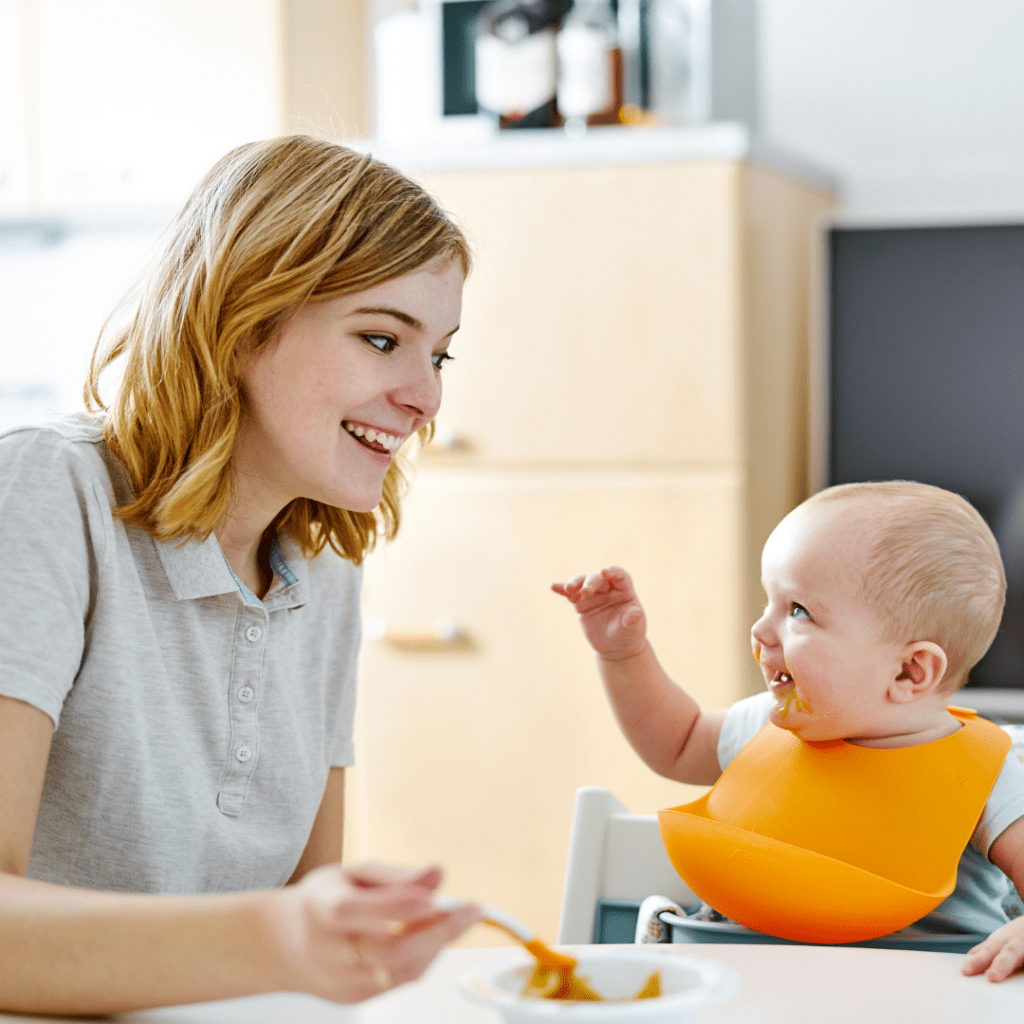
Lifesaving skills are an essential, yet often overlooked part of starting solids with infants. There are a lot of factors involved when you first introduce solids that I understand are important for making mealtimes stress-free. Knowing things like what foods to offer and what nutrition they need, are always going to be required. But learning how you could potentially save your baby’s life should be the top priority! Once you’ve mastered these lifesaving skills, you’ll be able to focus on making mealtime a fun and positive experience for the whole family.
By having an understanding of how to intervene appropriately should the worst-case scenario arise, you will feel less worried about gagging, can allow your baby to explore more textures and foods, and overall, you will foster happy mealtimes because you (and in turn, your baby) will be a lot less fearful.
Just like anything else, when you’re prepared and know better, you do better. Take public speaking for example – if you read your script numerous times and practice, you’ll be much more confident and relaxed when the time comes to deliver the speech. It’s important that your baby doesn’t feel your stress or anxiety to keep their experience of mealtimes pleasant, and to keep them feeling adventurous to try and experiment with all sorts of foods to prevent picky eating.
That’s why we recommend that every parent starting solids be trained in infant/child CPR to manage emergency situations confidently. If you know the best methods for how to react, you won’t have to second guess yourself and you’ll be able to keep yourself and your baby calm if you have to perform CPR due to a choking emergency.
Reason #5: Babies don't only choke on food

Getting ready to start solids indicates that your little one is getting older and will be hitting other milestones like crawling before you know it. Basically, they’re getting close to being able to explore the world around them more and more. And as exciting as that is…it also presents a lot more hazards.
You could be anywhere, at any time, and your baby may pick up a small toy, a rock outside, or really any other small object, and – POP – into the mouth it goes! Infants learn about the world around them by putting things in their mouths – I know it’s not our favorite trait as parents because who knows where those things have been – but it’s the reality.
I’ve heard from many parents who refuse to feed their baby without their…spouse, friend, or literally anyone, in the home because they don’t know what to do if they choke but someone else does. Well…you can’t depend on that safety net, so to speak, in every single scenario.
Eventually, your child will be on 3 meals a day and will likely have to eat at least one of them without your spouse home. You’re probably going to go out of the house, maybe go to playgroups or just play outside at the park. You cannot rely on someone else being trained in infant CPR as a means of protecting your child. You have no idea when choking will happen, or what will cause it, so it needs to be you that’s trained.
And that goes for everyone caring for your child as well. So ideally, both you and your spouse are trained, your babysitter, the daycare, and the grandparents that take them when it’s date-night. Whoever will be watching your child for ANY amount of time needs to know what to do in a choking emergency.
And that’s why I really love the option of getting the life-saving knowledge you need all online. An online course is perfect for new parents, parents needing a refresher, and all caregivers. You could even make it a requirement that caregivers complete the course before taking care of your child alone. You won’t have to struggle with finding a class to attend in time – get the knowledge you need as soon as you need it.
The bottom line here is this – you need to be trained in CPR. However you get that training, wherever you get that training – if it’s in-person or online. All of that is up to you based on what you feel comfortable with, how you learn best, what options are available to you, and of course, what you can afford. I’ve shared with you my top recommended option and I encourage you to check it out!
My favorite infant CPR course
In case I haven’t said it enough times yet…Safe Beginnings makes the ONLY online infant CPR class that I trust and recommend taking to every parent (and caregiver) – without hesitation.
If you want to know everything about keeping infants safe and how to respond during a choking incident, this infant CPR class covers everything you need to know. Safe Beginnings Infant CPR course is the most trusted online CPR class! And since we now know why CPR before solids is so important, let me show you what you get in the course.
The Infant/Child CPR, Choking and Injury Prevention eCourse will teach you:
- How to recognize an emergency and when to phone 9-1-1
- How to manage an unresponsive baby, child or adult
- How to perform CPR on a baby, child or adult
- How to help a choking baby, child or adult
- Includes maneuvers for pregnancy and other bodies that require modification
- PLUS! What sets them apart: their signature discussion on preventing injuries for babies and toddlers
Learn lifesaving skills for your whole family now! Click here for 20% off the course!
One of the things I appreciate the most about how Holly teaches is that she covers ALL the FAQ’s that have been asked over the many years of experience she has had teaching classes in-person and online. Take a look at all the points she covers in just these three sections of the course alone.
CPR section
Here’s what to expect:
- CPR: When and why?
- How to: Landmarking for CPR
- How to: How deep should we do CPR?
- How to: How fast should we do CPR?
- What if I need to leave to unlock the door?
- CPR demonstration, and more!
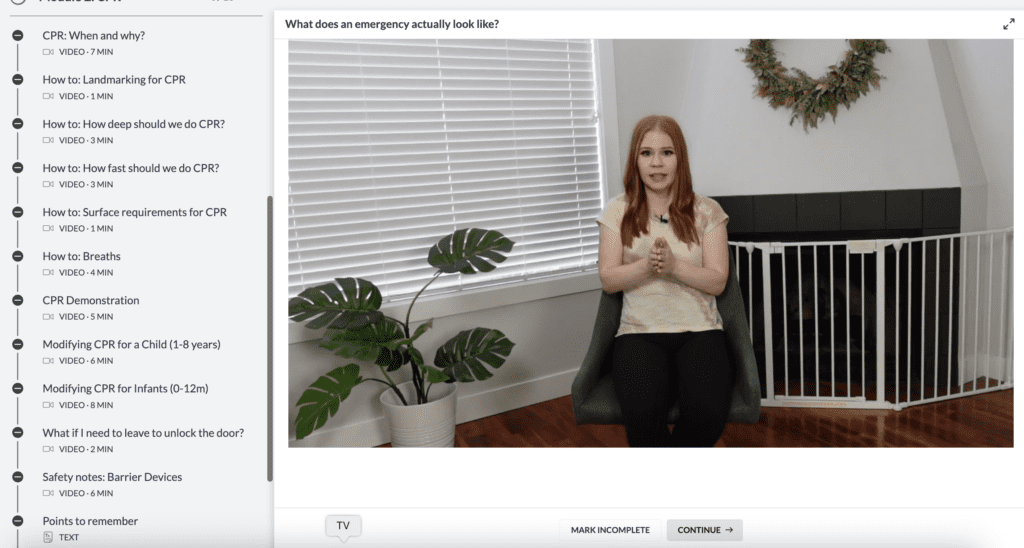
Choking skills section
Here’s what you’ll learn in this section:
- Choking: pregnant (conscious)
- Choking: Infant (conscious)
- When to switch from the infant maneuver
- Choking: Toddler (conscious)
- Choking: When the person goes unconscious, and more!

Injury prevention section (even includes car seat safety!)
Some of the topics covered are:
- Preventing burns
- Preventing falls
- Preventing drowning
- Car seat safety
- Recalled items, and more!

To top it all off, she wants to know that you know your stuff. So, she includes a mandatory quiz at the end of each section so you can feel confident in the knowledge you’ve obtained, that it’s stuck, and that you really do know the answers for what to do moving forward!
My Little Eater's Recommended Timeline
Parents always ask us when the best time to take one of our courses is. So here’s our recommendation for these two.
CPR class comes first
Get the infant CPR class done when your child is about 4 months old and have as many refresher infant CPR sessions as you think you need after that.
Get confident in performing CPR before moving on to anything else.
Next, learn all about starting solids
With the knowledge you need to save your child’s life in hand, you can now focus on the other aspects of starting solids. Begin our course when your child is 5 months old. Get to know what the readiness signs are to begin, how to safely serve…everything, what foods to start with, and more.
This process will ensure that you’ve covered all the bases and are truly ready to start solid foods by around 6 months of age (which is when most babies show all the readiness signs) – without rushing to get through the content. Fit it into your schedule, learn at your pace, and refresh as needed.
So, ready to bundle our Baby Led Feeding course PLUS Safe Beginning’s top-rated Infant CPR & Injury Prevention course? Grab the Baby Beginnings Bundle now and save!
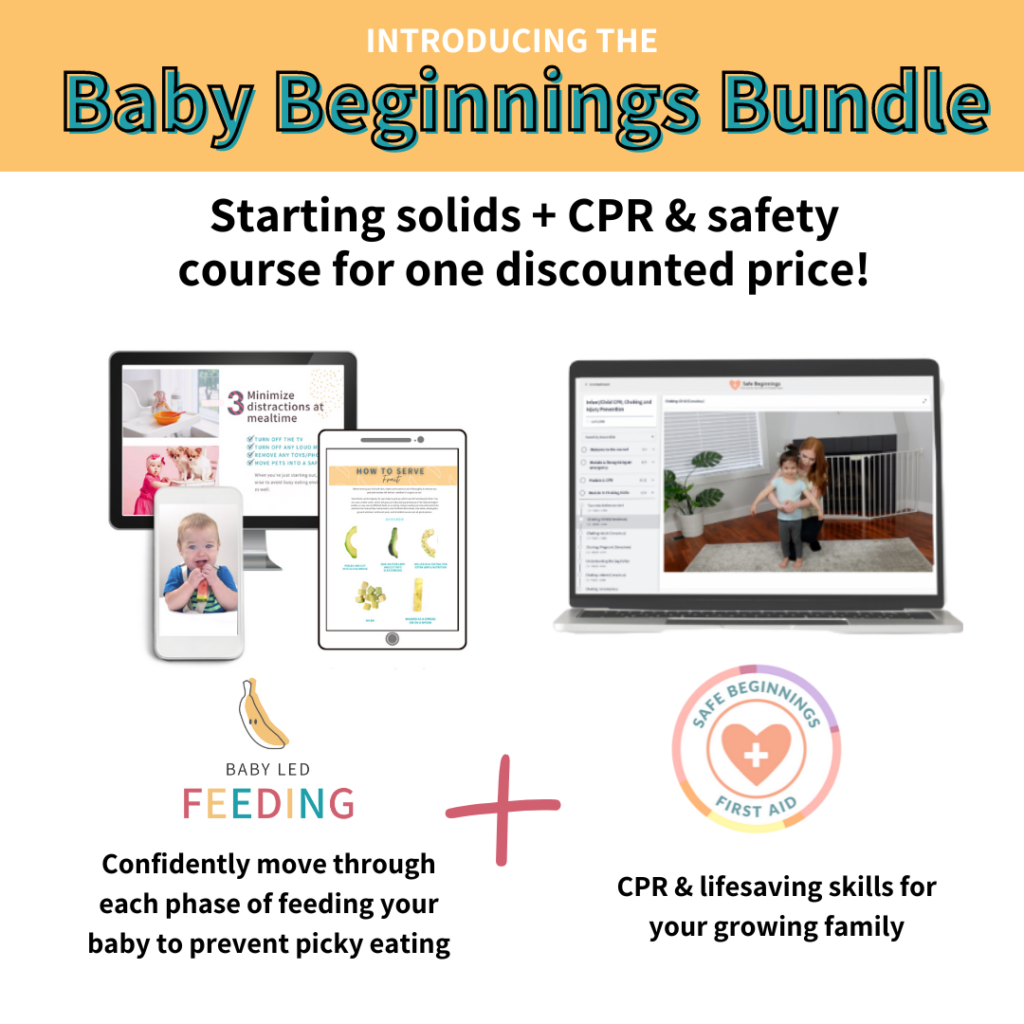
Found this helpful? Pin it to save for later!
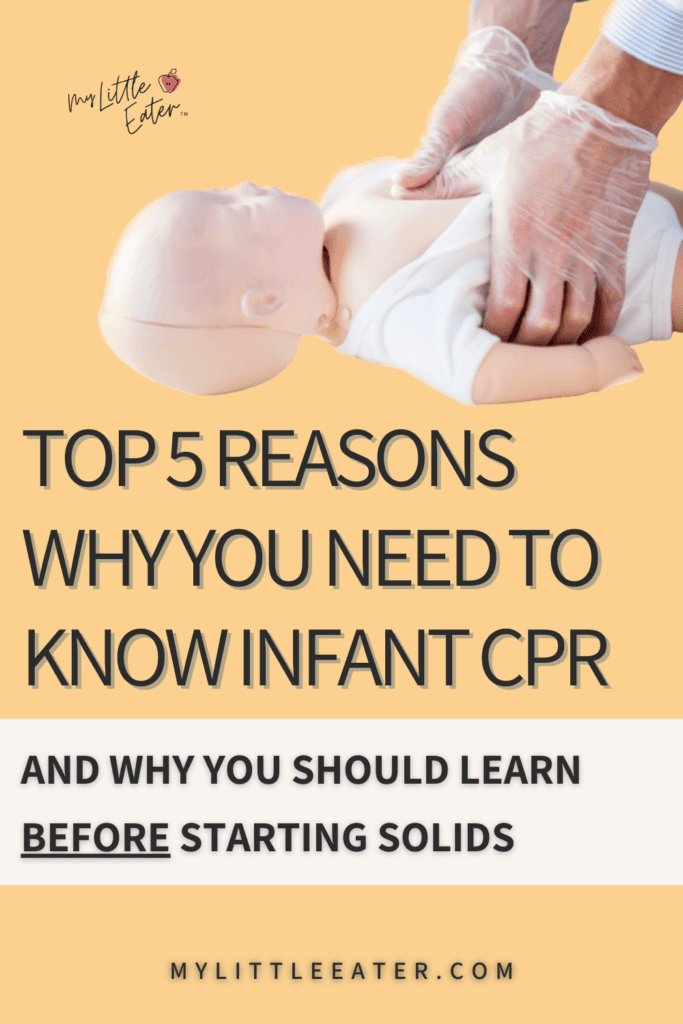
References
- Daniels, L., Heath, A. L. M., Williams, S. M., Cameron, S. L., Fleming, E. A., Taylor, B. J., … & Taylor, R. W. Baby-Led Introduction to SolidS (BLISS) study: a randomised controlled trial of a baby-led approach to complementary feeding. BMC pediatrics, 15(1), 1-15, 2015.
- Beaulne G; Health Canada. For the Safety of Canadian Children and Youth: From Injury Data to Preventive Measures. Ottawa: Government of Canada, 1997.

about the author
EDWENA KENNEDY, RD
Founder and lead Registered Pediatric Dietitian at My Little Eater Inc., creator of The Texture Timeline™, and mom of two picky-turned-adventurous eaters.

about the author
EDWENA KENNEDY, RD
Founder and lead Registered Pediatric Dietitian at My Little Eater Inc., creator of The Texture Timeline™, and mom of two picky-turned-adventurous eaters.
